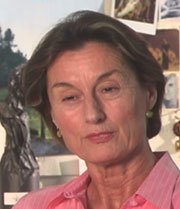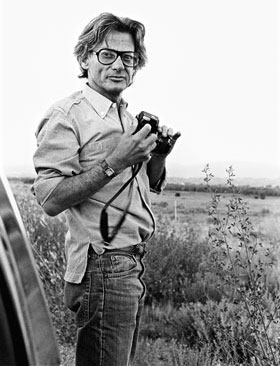 |
→ June 2004 Contents → Feature
|
Introduction to
Avedon at Work in the American West June 2004
|
 |
||||
|
Richard Avedon was fifty-five years old in October of 1978 and at the top of his game. He had spent his life photographing people of power, people of accomplishment and women of great beauty: Presidents Eisenhower, Kennedy, Ford and Carter. Samuel Beckett, Bob Dylan, Marella Agnelli. The Mission Council in Saigon. The Chicago Seven. Four major exhibitions in eight years had now culminated in a retrospective of his fashion work at The Metropolitan Museum of Art. "An Avedon portrait" had become a standard phrase in the art world's vernacular. His most unflinching work had placed him in the pantheon of the 20th century's greatest photographers. Except for trips to various photographic locations, most of his life had been spent within a thirty block radius of his studio on the Upper East Side of New York City. But only a month after his opening at the Metropolitan, he would begin to consider a new project that would take him into the American West. It started with a phone call from Fort Worth which is, as Texans say, where the West begins. Mitch Wilder, a photographer himself, was the innovative director of the Amon Carter Museum in Fort Worth. He had elevated the collection of Western art beyond the Remingtons and Russells so favored by the Museum's original benefactor, Amon Carter. Mitch liked the unexpected. Among his many acquisitions was a beautiful little painting by Pierre Bonnard. The painter had seen Buffalo Bill Cody's Wild West Show when it came to Paris in 1895 and painted two Indians galloping bareback on their ponies. Also in the collection, tucked amid the Catlins and the Bodmers, was a shadow box containing the actual upper lip and moustache of George Witherell who was hanged in Caņon City, Colorado in 1888.
Avedon was ready to go forward. He had spent almost forty years photographing people close to his own world in New York City: creative people, people from the worlds of fashion, theater and the arts. He was ready to take time out from the responsibilities of a demanding studio. Although he had worked in the South during the Civil Rights movement and in Vietnam during the Anti-War movement, he was anxious to complete his unfinished portrait of America. He knew that to widen this portrait, he needed to look at a whole different segment of society. He sensed that one of the great, hidden strengths of the nation came not so much from either coast, but from the country's interior and its hard working, uncelebrated people.
I first met Richard Avedon during a planning session with Mitch Wilder when my husband, knowing Avedon and the Museum would need a researcher to uncover photographic possibilities, introduced us. Bob and I lived in Dallas with our three young sons. I had been photographing the boys as they were growing up, taking pictures of the fun and exuberance of brothers: pictures of Andrew, our oldest son, diving off the roof of a summer house into Lake Sunapee in New Hampshire, pictures of all three, Luke, Owen and Andrew, in inner tubes in the swirling currents of the Guadalupe River in the Texas Hill Country. I loved the work of Jacques Henri Lartigue and the great photojournalists Robert Capa, David Douglas Duncan, Eugene Smith, and of course, Henri Cartier Bresson.
In preparation for this first meeting with Avedon, I looked through, as I had so often before, the four existing books devoted to his photography. The scope and magnitude of his work overwhelmed me. I was unsure if I had the experience for the job. But during this first session the strength of Avedon's personality soon drew me into his gravitational field, as it did most people who met him. He was 5'7", alert, buoyant, inquisitive, and full of visceral intelligence. Large, dark eyes dominated his face and made his black rimmed glasses seem insignificant. He had thick gun-metal grey hair, olive skin and a restless, nervous energy which made him appear a decade younger than he was. What distinguished him in person was the focus and intensity he brought to a conversation. His observations were disarming and he was quick in the extreme to respond to those around him. And I remember his conspiratorial approach. He'd make a side comment or witty remark, or just a glance to draw you closer. This, I learned later, defined him. He had an acute ability to connect: he knew intuitively the nature of a person and could sense both what a person wanted known and what withheld.
In spite of securing the Amon Carter Museum's support, Avedon wasn't sure he could make a go of it in the initial weeks of planning the project. In his contract, he had maintained the right to withdraw all the photographs if by his own standards he failed to measure up. He proposed a trial run, a test shoot, in March of 1979. He flew from New York to Dallas where we met and drove 205 miles to Sweetwater, Texas for the Rattlesnake Round-Up. This annual event, organized to rid the rangeland of snakes, sent farmers and ranchers, railroad clerks, and kids out into the countryside to flush snakes from their dens in the rocky ledges of the Callahan Divide country of West Texas. The Jaycees sponsored the Round-up, paying four dollars a pound per snake. Most years the hunters brought in about 7,000 pounds. But the rattlesnakes had to be alive - a dead snake is hard to skin and the meat spoils. Handlers milked the snakes for their venom which was used in medical research. The Jaycees Wives Club cut them up and deep fried them. The rattlesnake skins and carcasses were made into lively curios: paperweights and beer mugs, earrings and hat bands.
We wandered among the crowd looking for people to photograph. Two camera assistants from New York had come with us. They taped a 9 x 12 foot piece of white seamless paper to the shady side of the Sweetwater Coliseum and placed the camera on a tripod while passersby watched. Avedon used a large view-camera, a Deardorf, similar to the cameras used by photographers a century before. Sheets of film 8 x 10 inches were inserted one at a time into the back of the camera. The negative produced an image of unsurpassed sharpness which in turn yielded a print of exceptional detail. To focus, Avedon stepped under a black cloth; the image appeared upside down and backwards on the ground glass. But once focused, he was free to move to the front of the camera to face his subject directly. Nothing was between them. This permitted him the intimacy of eye to eye contact which would not have been possible if he were holding a camera up to his face. Because he wasn't actually looking through the lens, he had to imagine the picture he was taking. Only through experience was he able to sense what he had actually photographed; he couldn't really know until a print was made.
Avedon photographed with an intensity that precluded everything but the work at hand. With one assistant loading sheets of film and the other checking the aperture or shading the lens, he worked with surprising speed. He used the big, cumbersome Deardorf almost as if it were a 35 mm camera. His sense of urgency heightened the tension of a portrait session. There was nothing casual about the process. That first weekend in Sweetwater, I wondered why he worked so fast. It seemed to me that he might miss something. Later I understood that there is an optimum time with any subject after which attention fades. The speed and tension Avedon brought to a session transferred to the subject, concentrating the energy and compressing the space between them. This shared territory of intimacy allowed Avedon to see the slightest change of expression, to sense any shift of mood, to whisper encouragement and direction to his subject. The photograph became a collaboration.
The white seamless paper served to isolate the subject from the environment. "I wanted the thrill of the person to come forward out of the white," Avedon said. Landscape seemed to him to be a distraction. Within this strict, aggressively neutral framework, he experimented with the person's form, gesture and expression. Avedon photographed in the shade, using available light and avoiding the harsh shadows and highlights of sunshine that tend to dominate a face. He didn't use strobe lights because they gave photographs an artificial look. He sought the special beauty of shaded light. It has a neutral quality. It allows the emotion to come forward out of a face without directing attention through light and shadow to certain features. Avedon worked outdoors mainly during the warm weather months when people's bodies were revealed rather than in winter when they were bundled up in heavy clothes.
There is a world-wide impression of the American West, however ill-informed it might be. The writer John Graves who lives on "hard scrabble" land in Somervell County southwest of Ft. Worth once said to me, "Marlboro Country is always just a little west of where you are." The prospect of Richard Avedon, this most Eastern of photographers, heading West was unexpected, but the unexpected had always defined Avedon's work. Right from the start, he chose men and women who worked at hard, uncelebrated jobs, people whose lives were often ignored or overlooked. The Rattlesnake Round-Up in Sweetwater set his course.
For six straight summers from 1979 to 1984, I traveled with Avedon and his two assistants in a Suburban with our equipment packed into the back. We were on the road anywhere from one week to a month at a time. We crisscrossed the Great Plains and the Rocky Mountain states from Central Texas to the Sierra Nevada, from the Rio Grande to the Canadian border. In places like Hobbs, New Mexico and Hardin, Montana, people had never heard of Richard Avedon. It was through letters of introduction - and persuasion - that he was able to find and photograph his subjects. I planned each trip to take advantage of events where large numbers of people gathered. We searched through crowds for subjects and it was a numbers game to find the one person Avedon was looking for. Often chance played a part - the random glimpse of a drifter walking along Interstate 40 near Yukon, Oklahoma, or the brief conversation with a policeman in a tattoo parlor in San Antonio.
What Avedon saw was dictated by what he was looking for. And what he was looking for was not confirmation of John Ford's mythical vision of the West, but faces which expressed how he felt about the human condition. He headed in thematic directions dictated by what he had seen on that first trip to Sweetwater. He had several themes and he kept circling them. "I'm looking for a new definition of a photographic portrait," he told me. "I'm looking for people who are surprising - heart breaking - or beautiful in a terrifying way. Beauty that might scare you to death until you acknowledge it as part of yourself." He responded to the men and women who did the physical labor upon which most of the country depended, to the teenagers who committed too young to responsibilities too great. And he saw the results of helter-skelter lives played out against the isolation of an unforgiving landscape.
© Laura Wilson
|
|||||
Back to June 2004 Contents |
|
